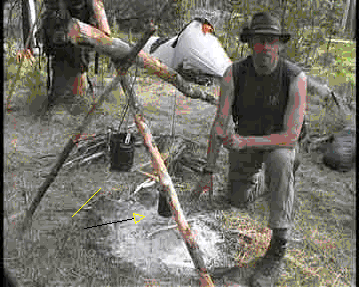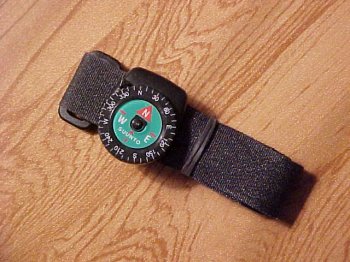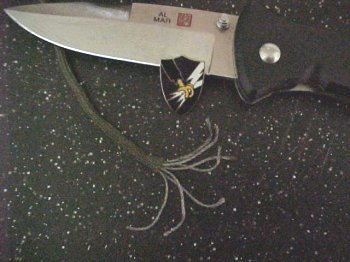
An Introduction to Wilderness Survival Instruction & Gear – On A Budget.
I love my gear. I’ve got tons of it, but for wilderness survival, how much of it is need, and how much of it is greed? What would it cost to have the basics of a "survival kit"? I think that the answers might surprise you. This is a basic overview of wilderness survival on a budget.
For wilderness survival, the good news is that expensive equipment (what the women in our lives call "your expensive toys") is not really as necessary as we might make it seem. The FIRST tool that you need is knowledge. Your mind is your primary tool!
Survival Priorities:
People who lack survival training usually make their first (and possibly LAST) mistake by not knowing their priorities. People once lost, go raging through the woods trying to get "unlost", "hunting" for food, or trying to light a fire when what they really need is a snug place to rest, out of the weather. Once you understand priorities, you can understand what you need and fix the problem.
"Exposure" (more properly called hypothermia) is what kills most people in the woods. Most deaths from hypothermia occur in weather from 30-50F. That’s warm enough that many people are outside with not enough clothing to sustain them, because they do not realize that excessive exposure to the "cool" weather is actually cold enough to kill them. If the person becomes lost, then you add to this: rain, wind, fear, exhaustion and nightfall and soon you have a first class emergency on your hands. In most cases your first need is to be warm, dry and out of the wind. You must seek or build shelter.
Shelter/Insulation begins with your clothing. Shelter is normally first priority, then water, then fire, then food. Notice that I placed food last? Most newbies ask about food first, but if you are from the average Euro/American lifestyle, you can live over two weeks without food, take off some of the jelly-belly and look like a rock star when you come out of the woods! Hunger takes weeks to kill a healthy person. Hypothermia can kill you in hours: priorities!
SIGNALING at any time may get you out of a jam, but don't walk in to the woods without knowledge and some basic gear. Relying on others for your safety is always a bad idea. People who do this end up with their pictures on milk cartons. Specialized environments like the Mojave desert, or tropical jungles have their special needs: priorities change slightly, but the general rule is:
Study, PRACTICE and in time you will OWN your skills.
Free or Inexpensive Training
"How can I learn skills like this, inexpensively? Joining an elite military unit to learn survival skills seems a little bit extreme." – (Author’s Note: "Sissies!" ;^)
Here are some other web sites besides this one which teach wilderness skills:
Hoods Woods - Ron & Karen Hood produce what I believe are the finest wilderness survival video series available. Each video tape costs only $19.95 and will teach, entertain and sometimes have you and your family rolling on the floor laughing. Learning by video tape gives you the 3D experience of being in the field, seeing skills being performed along with top notch verbal/visual instruction from Ron & Karen Hood. You WILL learn a LOT from their tapes. There is also a forum Hoods Woods Forum for questions and answers about many topics relating to survival. The forum is a rowdy place filled with close knit family, looking for new friends. I’ve been doing wilderness survival most of my life, but I’ve learned a LOT from Ron & Karen: so will you! Order their tapes, pop them in and learn. It’s great therapy for the down time between wilderness trips too. The next best thing to being there.
U.S. Rescue & Special Operations Group - Home Page will bring you to the U.S. Rescue & Special Operations Group. This is a civilian organization made up of former Special Operations people who do contract training of high level government and some corporate individuals in SERE. They are GOOD! This on-line site is a veritable encyclopedia of wilderness skills and naturally, in their business they are focused on the SpecOpns stud who is operating behind enemy lines. Even for civilians, their information is VERY usable, concise and clear about wilderness survival. Most survival manuals are "same-same". I’ve studied them all of my life, but theirs is a lesson book! If you want perfect composition, lots of glossy photos of professional models, get the Sears catalog. If you want a manual which will be a constant companion in the woods while learning the skills to remain alive – get the US R&SOG survival manual from their site.
Both sites are very good, practical and field proven. Go have a look-see and for the cost of Internet and a tape or two per month you'll receive a good beginning for a foundation in the academics of wilderness survival. How do you take it past a beginning? You go into the woods and practice with your hands what you have put into your head. Until you have done tasks with your hands at least few dozen times, I don’t believe that you’ve learned them. On the Hood's site we specifically teach how you can do this safely by going " survivalin’ "with a group of friends: we call it "Survival Camping" and it may save your life by having safety in numbers, extra blankets, sleeping bags, tents etc. at the ready. When your friends have set-up their camp, you then go away from camp, but still within yelling distance and build your survival shelter, collect natural insulation, fire materials etc. I’ve known people to do this in their back yards, experimenting with shelters, fire-beds for warmth… If it’s not going well, duck inside and think through what went wrong. The same for ‘survival camping’: have a tent and sleeping bag near by to duck just in case things are not working out. If you kill yourself training, you failed. This is not an easily recoverable error, so always have a back-up: perhaps your car near by with it’s heater and some munchies. Think about it…
The most difficult concept to teach students are the survival priorities. Most people die because they are not certain what they need to stay alive. Read Ron Hood's on-line book and you will begin to see why expensive equipment is nice, but not necessary. The focus is on skills, using your environment properly and scrounging. This thought process is your most valuable survival tool. As you develop SKILLS, you reduce the amount of gear that you need.
I highly recommend that at some time in the process of learning wilderness survival skills, that you go on a survival training trip under the guidance of qualified instructors. In an environment of professionally qualified instruction, you will learn much more, because you will be doing much more. Instruction is designed to get you out of your comfort zone and into a learning experience which you are not likely to safely enter on your own. Instructors provide you with guidance and a ‘safety-net’ should you not get it right the first few times. A reputable survival instructor will have your safety as his primary responsibility. In Idaho, where I teach wilderness survival skills, survival instructors are required to hold valid outfitters and guide licenses. This ensures that the instructors meet certain safety, personal qualification & accountability standards. If you are interested in what this level of wilderness survival instruction provides, please visit my Wilderness Survival Training website and have a look around.
What Does a Po’Boy Put Into The Survival Kit?
Here's what I would do - on a budget.
1. Sheath knife, 5" blade or longer. Longer is better for many tasks. The Army/Air force survival knife is good, so is Kabar, Camillus, Buck and Becker (the Becker Brute, TAC Tool and Campanion are very good tools which will last a lifetime, but more expensive). At the present time, the surplus blades are priced at between $25-$35 if you shop around for a bargain. The Becker knives are $80-100, but can sometimes be found for less. One of the BEST deals on the market is the Cold Steel Bushman. They can be had for about $13. They ARE bare bones, but they wear like iron, are jungle tested and easy to maintain. They are designed to easily make into a usable spear head in a way that I would never use my regular knife. (Don’t throw your knife. MAKE a weapon or trap with your knife) That's an amazing amount of utility for a small price.
"You can do small knife work with a big knife, but you can NOT do big knife work with a small one."

WARNING: Never strike your knife with a rock, pipe or other object that may damage it. Use a wooden club. You are only as sharp as your knife!
When all wood in your area is wet from driving rain and snow, your best source of dry wood to start or maintain a fire is often found by quartering and splitting dead wood until you have plenty of dry kindling, fuel and quartered logs. Remember, standing dead wood is usually wet for the first 1/8" or less. You could do this with a pocket knife by carving a wooden wedge and driving it into the log you wish to split, but it’s quicker with your long’ish knife.
2. Coffee can. You cook, carry water, boil water to make it safe to drink, make stews, dig, use as a drum set..... Don't go into the woods without one. Make a handle to hang it over the fire by using a coat hanger wire bail inserted into two holes punched into the top lip of the can. Use the can to carry your survival kit.

4 Trash bags, large, construction weight, black/hunter orange. These are GREAT as a poor man's poncho, waterproofing for the roof of your shelter, to make WARM wilderness quilts by filling them with leaves, pine duff, cat tail fluff, carrying water. (You can tie off the bottom of a pair of trousers, put a bag down each leg, fill both with water and carry many gallons for miles by draping it over your neck/shoulders. If you only have one pair of pants, then you give everyone a good show... ;^) Put a gallon or two of water into a trash bag and lay it flat on the ground or a warm rock to heat wash water in the sun, melt snow for water without using fuel. (Treat your snow water by boiling it in your coffee can! Remember: snow heated is not the same as treated!). Use trash bags in place of the "Space Emergency Blankets". I like Heavy space blankets, but trash bags have more utility for less weight, less cost and ease of replacement. You’re not worried about cutting and using trash bags, after all, they’re designed to be thrown away!
4. Canteen This can be a one or two liter, plastic ‘pop’ bottle, or if you have a few extra bucks and want ‘bragging rights’, a Nalgene bottle from the outdoor shop slides right inside of your coffee can cooker and you can still wedge a big soup spoon in between the can and the canteen. A complete cook kit for about six bucks. Wrap several layers of "Duck" tape around the top of the bottle. You can never have too much duck tape! A shoulder strap can be tied around the top and the bottle is always handy. I’ve seen old trouser legs used as a cloth case for these bottles, slip the cap through your belt before you screw it back on and it’ll stay in place or if your rucksack has a ‘sternum strap, you can do my favorite trick and run the sternum strap through the coat hanger wire handle on the cook can and slide your Nalgene bottle into the can. It keeps your water right in front of your chest for easy access reminding you to hydrate-or-die. Wearing your water bottle on your front off-sets the backward pull of your pack allowing you to walk more upright. Your canteen is for TREATED water only.
5. Folding "garden" saw from Sears etc. This will allow you to cut wood, gather fuel and make traps with MUCH greater efficiency and stealth than any of my high dollar knives and axes. A Saw is VERY efficient! This is why lumber-jacks send their timber to SAW mills, not "Big Knife Mills"… Think about it (but I STILL insist on a knife 5" or preferably larger.) My saw cost me $9, but that was many years ago. The next step up is the "Wyoming" style camp saw. Basically this is a bow saw that is designed to fold down flat and be easily portable. Buy spare blades and keep them enclosed so that they do not damage your pack and equipment. (Also called the "Sven Saw".)
6. BIC lighters & Tinder (carry two or more lighter & tinder kits in separate places) Cotton balls with a little bit of Vaseline rubbed into them to be used as tinder under adverse weather conditions will keep you in fire - EASILY. I carry several different models of "ferrocerium" rods, AKA: "sparking rods" which I use for fire. BIC lighters can be bought by the bag full for under $5.00 and the BIC brand is VERY reliable. There is more to learn about fire-by-friction etc. from the sites above and PRACTICING. It RARELY goes right the first two dozen times.... ;^) Matches are a waste of space! (You might want to read that again.)
7. A CD (AOL mails millions every month) goes into your kit as a signal mirror! They work WELL with practice. Take your friends, kids, or friend's kids out to a big field and practice "flashing" each other..... better make that "SIGNALING" each other until it becomes second nature to be able to put flash on the target. It is not as easy as it sounds. Mirror flashes can be seen for over a dozen miles. Search & Rescue aircraft are especially vigilant for mirror flashes. Practice makes perfect. (Do NOT practice with aircraft, police, military…. ;^)

Hold the CD in front of your eye with the reflective side facing the person you wish to signal. Raise your hand and make a "peace sign" with the person to be signaled between your fingers. Turn the CD until you see the light flash across your fingers. Flash three times, pause, flash three times, pause & keep doing this until you can see that they have spotted you. Repeat as necessary
8. Compass – I teach land navigation among other topics. Improvised direction finding using the sun, moon, stars, Ottomani sun compass, wrist watch are important skills. I’ve used these skills all over the world in shopping malls to remember where I was parked… ;^) On the other hand a button compass like the one shown is inexpensive and outperforms any of the improvised methods, does not require a clear sky and sits on your wrist constantly reminding you of your direction of travel. The best way to not get lost, is to know where you are by taking mental or written notes of your direction of travel and estimated distance. Read that again. If you walk west from your car parked on a road and the visibility drops to near zero, then you would probably seek shelter & warmth to wait it out. A $6.00 compass and some practice and knowledge (both free) will save your bacon by showing you the definite direction to travel to return to the road!

A $6.00 wrist compass can save your life.
9. “550” Cord. I HIGHLY recommend that you carry 20-50 feet of 550 cord, also known as parachute cord. Real 550 cord can hold a dead weight of 550 pounds when new and is made with 7 to 9 inner strands which are good strong string. Each inner ‘string’ can be untwisted and used for smaller jobs if required. I use the inner strands for fishing, sewing and many tasks around home. The outer sheath is cordage which is good for everything from boot laces to shelter building.

Buy only REAL, G.I. issue, 550 cord. Cut the end off in the surplus store and make certain that it has 7 or nine inner strands! It may still not be genuine G.I. but anything without the inner strands is definitely fake.
10. Soap! And a small rag/bandanna. The ability to wash is VERY important to your health. One of the major reasons why we are free from large scale disease and infection is our cultural obsession with personal hygiene. A half bar of soap tied in an old, thin sock is a great people scrubber. When finished, swing it around like a dead chicken to shed most of the suds then hang it on your pack to dry. Included in this is your toothbrush and dental floss. If you don’t take care of your teeth, especially with the “delicacies” you’ll be eating in the woods, in a short time your mouth will smell & taste like a Hanoi sewer. Long term neglect of your dental health will make life miserable for you. The dental floss is also one of the most useful items in your kit. Besides cleaning your teeth, you can use it for fishing line, trip wire, making bow strings, and for sewing cloth, leather and flesh (ouch!).
11. Toilet-Rag. You heard right "toilet-rag". We ALL have to "go" sooner or later, and toilet paper has a BAD utility to weight ratio, messes up pristine wilderness areas and leaves a monument to yourself anywhere you …. Well, "GO"!. A toilet-rag can be an old T-shirt, anything absorbent that you can rinse in the field. (Only snobs use toilet-rags that say "dry clean only"!). MAKE IT DISTINCTLY DIFFERENT FROM YOUR HEAD RAG, FACE RAG OR ANY OTHER RAG, or else some dark night you will get a big surprise! Ps. It hangs on the outside, rear of your pack to dry. If you are comfortable using smooth round stones, smooth branches, etc. feel free, but the toilet rag is in your kit for the times when these options are either not available (under three feet of snow, nothing but desert sand for miles…) or are undesirable (did I REALLY get all those fire ants off the stone???)
12. Emergency Food Kit. In a survival situation, your body needs all the “stuff” that we are told to stay away from in the city: high calories, fat, salt and sugar. That’s because a Survivor is burns MUCH more energy in the woods than he does back at his TV set. The good news is that for all the expensive high-tech foods that have been developed by rocket scientists at NASA, for the Po’Boy, nothing beats good, cheap, Peanut Butter! Look at the label on the jar. Two spoonfuls of my cheep, chunky peanutty putty give me 274 calories in two spoon fulls. It also gives me salt, sugar and a bunch of long words that only a chemical engineer would understand. Does it work? Well, Elvis was a lean, mean fighting machine, but he became a butter-ball after a few years of eating fried peanut butter and banana “samiches”. Listen to “The King”, bring peanut butter to the woods. They don’t call it “Chunky” for nothing! If you want to do it in style, go a backpacker store and buy some of their refillable Squeeze Tubes and heat the peanut butter so that it will easily pour into the tubes – mix in honey to taste if you want a little more zip. Salt, is an essential, “Sports/Energy drink mix, will keep your electrolytes and sugar levels up. Hot sauce (I like Sri Racha Viet Namese/Thai hot sauce) makes almost anything into “food”. Spices we have already talked about. I recommend: Tabasco, Curry, Garam Massala (Indian spice), Chili powder, Chinese Five Spice,… you get the idea. Bouillon cubes are a great source of warm, fatty and salty liquid to warm you up when you’re cold and will change marmot and cattail in a can of hot water, into a real stew!
Niceties & Longer term Items:
Watch Cap (for me, an essential), DEET!, work gloves, plastic drop cloth, PolarPur, spoon, Head net, , Bouillon cubes, polysporin, hand trowel. Finally, I bring spices. They weigh almost nothing, take up almost no space, but they make the strangest things into “delicacies”. Having traveled a lot in some of the lesser known places in the world, if you’re going to be eating “third world”, bring third world spices! Fishing hooks, snare wire - 22 gauge or so from the hardware store. I use stainless steel /smaller gauge/ or brass, but any wire will do if you know what you’re doing) Buckshot's Camp is a great source to learn trapping, snaring and how to feed yourself in the woods and to purchase professional grade materials.
This article is intended to be an introduction to wilderness survival. There is more – much more. However, if you don’t take the time to learn wilderness skills, then all this gear can be replaced for free with a bag of rocks. No skills = No Survival. This article is intended to give you a good start and some ideas for learning & practicing the skills and putting together gear which is small, light and inexpensive enough that you and your family can have the basics with you, put kits into your cars and do it on a family budget.
RadioRay..._ ._
RadioRay's Wilderness Survival Training Web Site
All materials at this site not otherwise credited are Copyright © 1996-2002 Trip Williams. All rights reserved. May be reproduced for personal use only. Use of any material contained herein is subject to stated terms or written permission.